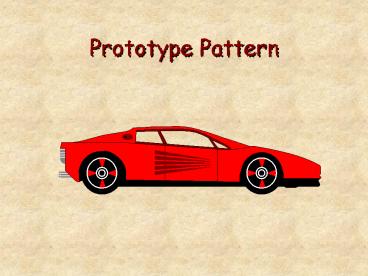Prototype Pattern - PowerPoint PPT Presentation
Title:
Prototype Pattern
Description:
implements an operation for cloning itself. Client(GraphicalTool) - creates a new object by asking a prototype to clone itself. Applicability ... – PowerPoint PPT presentation
Number of Views:41
Avg rating:3.0/5.0
Title: Prototype Pattern
1
Prototype Pattern
2
Creational Pattern
- Specify the kinds of objects to create using a
prototypical instance, and create new objects by
copy this prototype.
3
Problem
Problem The GraphicTool class
belongs to the framework, while the graphical
classes are application-specific, so the
GraphicTool class doesn't know how to create
graphical objects and then operate on them.
4
Solution One
This method will produce many subclasses that are
different only in the kind of music objects they
instantiated.
5
Solution Two
6
Structure
- Participants
- Prototype(Graphic)
- declares an interface for cloning itself.
- ConcretePrototype
- (Staff,WholeNote,
- HalfNote)
- implements an operation for cloning itself.
- Client(GraphicalTool)
- - creates a new object by asking a prototype to
clone itself.
7
Applicability
- The prototype pattern is used when a system
should be independent of how its products are
created, composed, and represented and - when the classes to instantiate are specified at
run-time for example, the dynamic loading - to avoid building a class hierarchy of factories
that parallels the class hierarchy of products
or - when instances of a class can have one of only a
few different combinations of state
8
Consequences
- Isolating concrete product classes from the
client. - Dynamically adding and removing products at
run-time. - Specifying new objects by varying values.
- Specifying new objects by varying structure.
- Reducing the need for sub-classing.
- Configuring an application with classes
dynamically. - Main liability Clone() needed.
9
Implementation
- Using a prototype manager.
- Implementing the Clone operation.
- Initializing clones.
10
Questions?































